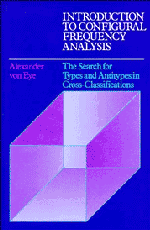 Introduction to Configural Frequency Analysis
Introduction to Configural Frequency Analysis Book contents
- Frontmatter
- Contents
- Preface
- Part I Concepts of configural frequency analysis
- 1 The analysis of contingency tables
- 2 Testing for types and antitypes
- 3 Models of CFA: concepts and assumptions
- Part II Applications and strategies of CFA
- Part III Methods of longitudinal CFA
- Part IV Strategies of CFA and computational issues
- Appendix A Computational issues. The estimation of tail probabilities for the standard normal and the F distributions
- Appendix B Estimation of expected frequencies in 2 × 2 × 2 tables under the assumption that main effects and first order interactions exist
- Appendix C Critical alpha levels under Holm adjustment for up to 330 cells and a priori alphas 0.05 and 0.01
- References
- Subject index
- Author index
1 - The analysis of contingency tables
from Part I - Concepts of configural frequency analysis
Published online by Cambridge University Press: 04 August 2010
- Frontmatter
- Contents
- Preface
- Part I Concepts of configural frequency analysis
- 1 The analysis of contingency tables
- 2 Testing for types and antitypes
- 3 Models of CFA: concepts and assumptions
- Part II Applications and strategies of CFA
- Part III Methods of longitudinal CFA
- Part IV Strategies of CFA and computational issues
- Appendix A Computational issues. The estimation of tail probabilities for the standard normal and the F distributions
- Appendix B Estimation of expected frequencies in 2 × 2 × 2 tables under the assumption that main effects and first order interactions exist
- Appendix C Critical alpha levels under Holm adjustment for up to 330 cells and a priori alphas 0.05 and 0.01
- References
- Subject index
- Author index
Summary
In empirical sciences, many data are categorical, that is nominal or ordinal in nature. Examples of nominal variables, which are essentially qualitative, include membership in political parties, religion, sex, and presence or absence of illness. Examples of ordinal variables, which rank observational units according to the relative degree to which they possess a particular attribute, include grades in school, severity of illness, and psychometric scores as measures of cognitive complexity or creativity.
The states of categorical variables are mutually exclusive. Therefore, every individual can be assigned to only one state per variable at a time. When two or more categorical variables are measured they can be cross-classified so that every variable may be observed under every state of every other variable. When d variables are cross-classified, a d-dimensional contingency table results (with d ≥ 2).
Consider, for instance, the three variables extraversion (E), criminal behavior (C), and intelligence (I), with categories as follows: E1 = extravert, E2 = introvert, C1 = presence of criminal record, C2 = absence of criminal record, I1 = high intelligence, and I2 = low intelligence. These three variables can be crossed to form a three-dimensional contingency table that has 2 × 2 × 2 = 8 cells. Table 1.1 presents the eight elementary cells of the present example in tabular form, along with labels specifying the states of each variable.
- Type
- Chapter
- Information
- Introduction to Configural Frequency AnalysisThe Search for Types and Antitypes in Cross-Classification, pp. 3 - 15Publisher: Cambridge University PressPrint publication year: 1990
- 1
- Cited by


